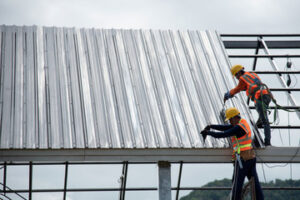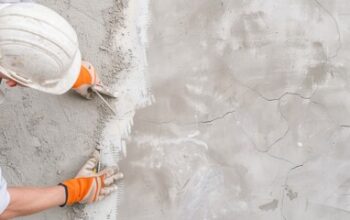The roof is a building’s main shield against the elements. It is a complex structure that requires careful inspection and maintenance.
Watch as professionals keep a job site clean, strip and repair the sheathing, and layout and install new shingles. You’ll also see how to install  step flashing and ridge vents. Visit https://www.lakewood-roofing.com/ to learn more.
step flashing and ridge vents. Visit https://www.lakewood-roofing.com/ to learn more.
Roofing is one of the most essential components to a home or business, offering protection from rain and snow while contributing to the overall aesthetic. It’s also a highly adaptable building material, reflecting cultural, climate, and technological developments throughout history. From primitive thatched roofs to today’s high-tech, energy-efficient solutions, the evolution of roofing is a testament to human ingenuity.
Some of the earliest dwellings included a thatched roof, constructed from dried vegetation like straw, reed, and heather. Thatching was an easy and cost-effective way to prevent water, sleet, and snow from seeping through the top of a structure. It was also a good insulator, keeping structures cool in the summer and warm during winter.
As societies advanced, other roofing materials became more prevalent. Wooden shingles were common in early North American homes, while clay and slate tiles became popular in medieval Europe. These new materials offered greater durability and fire resistance than thatch. In addition, the interlocking design of slate and clay tiles helped prevent leaks.
By the 19th century, manufacturers had worked out many of the kinks in their roofing materials. Heavy paper covered with a tar-saturated material like pine or coal tar became an important component of many roofs. In the 1930s, asbestos was widely used in construction and was an effective waterproofing agent until researchers discovered how dangerous it was to be exposed to it.
In the 1970s, builders and roofers started looking at roofing not just as a cover for buildings but as an energy-saving device. They began using roofing materials that bounce back the sun’s rays instead of absorbing them, allowing buildings to stay cooler and cutting down on energy bills.
Materials
There are many roofing materials on the market today, each offering its own benefits and drawbacks. Some are made of natural products such as thatch or clay tiles. Others are manufactured. Most are placed over a secondary water-resistant material called underlayment.
The type of roof you choose will depend on your budget and the style of house. Asphalt shingles are the most popular and least expensive. They are available in a wide range of colors and styles to suit your home. They can be found in three basic varieties: 3-tab, architectural and luxury asphalt shingles. Slate-like ceramic tile is an elegant choice that can be quite costly. This is most often seen on Frank Lloyd Wright-designed homes and has the longest lifespan of any of the roofing materials, but they can be difficult to install.
Metal roofing has become more popular in recent years due to its durability and energy efficiency. It is also a good choice for flat roofs because of its resistance to UV radiation and punctures. It can be very durable in various climates but may require periodic maintenance to keep it free from corrosion.
Wood shingles are another common roofing material. They can be very durable when used with a high-quality product and well maintained. Cedar shingles, for example, are known to last up to 30 years when properly cared for and can offer excellent insulation value.
Underlayment is a protective layer of waterproof material that goes between the roof deck and the roofing material. It is typically installed over joists, beams or trusses. It is a critical component of any roofing system. A common underlayment is a #15 asphalt-impregnated builder’s felt, also known as tar paper. Woven polyethylene underlayments, however, are becoming increasingly popular and may be better suited for high-end jobs or homes built with modern materials.
Installation
Roofing is the outer covering that safeguards the structure of a building from weather. There are a wide variety of materials available for residential and commercial spaces, each with its own advantages and disadvantages. Choosing the right material for a building requires careful consideration of its design, construction, and maintenance requirements, as well as local climate conditions.
The first step in any roofing project is to remove the old shingles and underlayment. This can be a messy and time-consuming process, but it is essential for a smooth installation. Once the sheathing and any other underlaying layers are removed, the shingles can be laid out in their proper pattern. It is important to note that the underlayment acts as a second line of defense, protecting against leaks and moisture infiltration even if the top layer suffers damage.
When laying the shingle strips, it is important to start at a corner and work your way out to the center of the roof. It is also a good idea to chalk a line on the underlayment immediately above each strip for a guideline. This will ensure that the shingles are properly aligned and spaced, helping to prevent leaking or other problems down the line.
Once the shingle strips are in place, the last step is to install the flashing and ridge caps. This can be a tricky job, but it is important to take all the necessary safety precautions, especially if you are working up high. It is a good idea to have someone else working with you and to use a ladder that is securely anchored. It is also a good idea to wear gloves, safety glasses, and sturdy shoes or boots.
Recovering an Existing Roof
In some circumstances, an existing roof can be recovered instead of replaced. However, there are a few conditions that need to be met before this can be done. First, the roof must be structurally sound and in good condition. If not, a recovery may not be the best option. It should also be determined if the roof can support another layer of roofing material. If the structure cannot handle the additional weight, a full replacement will be required.
There are several different ways to recover an existing metal roof. Some of the more popular methods include a Hat and Scat Retrofit, Grid Retrofit, Tall Clip and infill with rigid insulation. Each method has its advantages and disadvantages. These should be discussed with a roofing contractor to determine which is best for the situation.
The roof must also be properly insulated to avoid moisture penetration into the existing structure. This can be done by installing a new insulation board under the existing cover boards. A separation board is also needed to separate the old roof system from the new. This can be made of a traditional cover board or a more advanced material such as isocyanurate.
Depending on the type of roofing used, there are some limits to how many layers can be added. Metal roofs can only have one overlay while asphalt shingle roofs can only be re-roofed with two layers. It is important to check with a roofing contractor to see what the building code allows for and what types of roof coverings are acceptable for recovery.
It is also important to remember that re-roofing will only extend the lifespan of the roof by a few years. If the roof has major leaks or other issues, it will still need a full replacement to maintain its structural integrity.
Re-roofing
All components of your house are important, but none more so than the roof. The roof protects everything within, keeping moisture from seeping in and wreaking havoc. It also enhances your home’s curb appeal and increases its value when you decide to sell. That’s why reroofing is often viewed as an attractive option for homeowners who are looking to save money and still enjoy the cosmetic perks of a new roof.
The deciding factors for whether or not a homeowner should opt for reroofing are the material type, slope, age and other specifics of the current roof and property. It’s important to weigh all of the facts and make the best decision for your situation. A re-roofing job might delay potential leaks and may add a few more years to your roof’s lifespan, but the end results are less than satisfying in terms of quality.
A roofing contractor will carefully examine your roof to determine if it is a good candidate for re-roofing. If it is, then they will work to remove the old shingles and replace them with new ones. Then, the vapor barrier and other necessary layers will be added to protect the roof from the elements.
Re-roofing is ideal for older asphalt shingle roofs that are showing signs of wear and tear but still have a good amount of life left in them. However, if the shingles are already in bad shape and it’s obvious that they won’t last much longer, then a roof replacement might be the better option.


